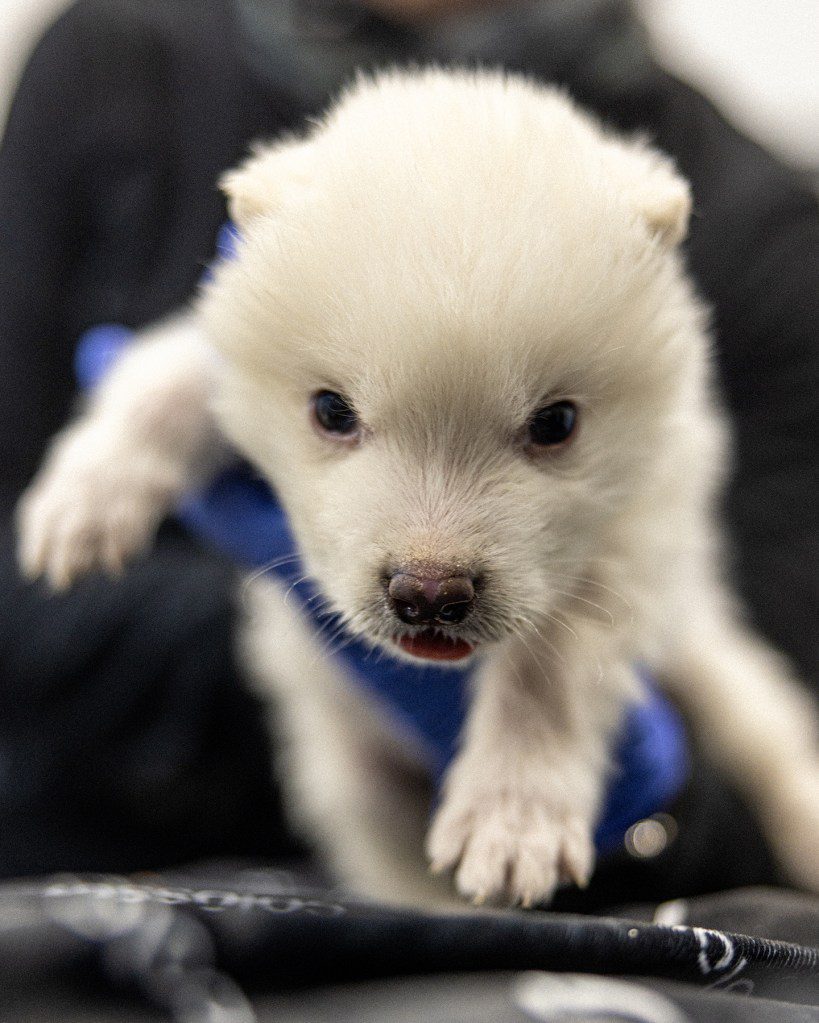‘It’s Like I’m Dancing With Death’: Inside One of the World’s Most Dangerous Games
I
N THE COLISEUM, the bull stares down hundreds of men. He’s a half-ton killer, black, head white like a skull, horns curled. Bred for the fight. There’s violence in his DNA. The bull scans the crowd in the ring, alert to any challenge. The crowd watches for the animal’s slightest of movements. When the hundreds of men flee, they move in tandem, like a school of fish dodging a shark. The blazing tropical sun beats down on us all.
From the crowd steps a man. Catalino Bravo wears the face of a clown, white paint over his black skin, a nose daubed red. Something’s crazed in his eyes. An entirely sane man would not yell at an enraged 600-pound bull that stands 30 feet in front of him.
“Hey! Hey! Hey!”
The 25,000 or so spectators cheer Catalino. In the stands, one of the band’s drummers is lost in his solo. The drums beat faster and faster.
“Hey! Hey! Hey!”
The bull settles his gaze on Catalino and stomps the ground, shooting dust into the air. Catalino takes two steps forward, two steps back, revving his body. Rapt, the audience watches. The drums pound in a frenzy, and Catalino again shouts “Hey! Hey! Hey!”
The bull charges. The audience cheers, the audience screams. Quickly crossing himself, Catalino sprints — straight at those horns. Now everything happens faster than the brain can process. Why is this man running at the charging bull? How can he survive? What the fuck is going on?
The audience is on its feet, hollering. The drum solo keeps going, faster, madder. The man and the bull charge each other, erasing meters in a second.
There is music and drinking at every corraleja. “This is our tradition,” says one attendee.
Carlos Parra Rios
At the last moment, when it seems inevitable that Catalino will be gored, everyone holds their breath. Inches from those murderous horns, Catalino launches himself into the air, soaring over the bull. The bull steamrolls forward, and Catalino lands in the dirt in a roll and jumps to his feet.
The crowd hollers, shaking the wooden pillars, threatening to bring down the entire coliseum. The “jump of death,” a trick that has cost men their lives, had been perfectly executed — this time. A second too early or too late, the bull could hook Catalino, ripping him open. Now, he runs around the ring, celebrating like a champion. From the stands, adoring spectators throw money down to him.
“This sport is for psychos,” Catalino says afterward, his eyes still glowing from the adrenaline.
These are the corralejas, bullfighting Colombian-style. The corralejas mix San Fermín’s Running of the Bulls, where the brave, the drunk, and the dumb outrun marauding bulls, and Spain’s traditional bullfighting. But with important differences. Here the bulls don’t die. Only the men.
For more than a century along Colombia’s Caribbean coast, hundreds of men — many loaded on rum and beer — have crammed into rickety wooden coliseums to test their bravery with the bulls. I’ve spent more than a decade watching the corralejas, drinking the rum, seeing the bulls, learning the rules and eccentricities. Over an afternoon, 36 bulls are released, one at a time, to tear through the crowds of men. After five minutes or so, the bull is lassoed and led out of the ring, and the next animal barges out of the metal doors. Most of the men are there as voluntary cannon fodder for the spectacle. Their mission: Stay off the bulls’ horns. The slow, the unlucky? The bull gets them. But a core of some 50 men are professional bullfighters like Catalino, who earn their living in front of the bull. The “Suicide Men,” they’re called. Injuries are daily. Deaths are common. Supporters and critics alike compare it to the gladiator games of ancient Rome.
In the stands above, tens of thousands watch the show, dancing to live orchestras. Old women, shots of rum in their hands, laughingly repeat the event’s motto: “If no one dies, it’s not a corraleja.”
It’s a six-day dark carnival of music, rum, blood, and madness. One of the world’s deadliest sports — and its time might soon be up.
This sport is for psychos. Death is always at your side, even if you can’t see her. —Catalino Bravo
TRADITIONAL BULLFIGHTING was brought over to Colombia by the Spanish colonizers, an Old World pastime for the New. In Spain and parts of Latin America, they had corraleja-style events in small towns in eras past. Closing off the town plaza, men performed daredevil tricks with bulls provided by local wealthy cattlemen. But over time, these were outlawed or abandoned as too dangerous. Except here on Colombia’s Caribbean coast. The history is murky, but the few historians of the corralejas believe they started in the first half of the 19th century in the flatlands of the provinces of Sucre and Córdoba, where the business is cattle. These are beautiful, baked landscapes topped with thick tropical clouds that cut like white mountain ranges against the pale-blue sky. The people along the Caribbean coast are known as Costeños. In the faces you see traces of Africa, Europe, and the Indigenous of the Americas. They are proud of their region, heritage, and local eccentricities. Just half an hour down the highway from this corraleja, the town of San Antero holds its annual donkey beauty contest.
The World Bank confirms what your eyes see in this country of small oases of wealth surrounded by widespread need, calling Colombia “one of the most unequal countries in the world.” Nearly 40 percent of the country lives in poverty, close to 14 percent in what is classified as extreme. These farmlands of the coast are concentrated in the hands of a small number of families, massive cattle ranches that stretch over the horizon. It feels close to feudal. And maybe that is part of this story: a legion of young men who know their chances of rising high are small, and so see in the ring a path. In the corralejas, the poor man can become someone, but the price is blood.
Spectators adore the event. They use words like “excitement,” “party,” but mostly “tradition.”
“I love the action … the adrenaline of the bulls,” says Cristina Osorio, standing outside of the ring. “There aren’t any rules. Anything goes for the party. It’s six days — enjoy yourself to the max.” And then she says something you’ll hear at every corraleja. “The corralejas — you carry this in your blood.”
Luis Baldovino, a YouTuber who films corralejas for his El Show de Frijolito TV channel, comes whenever he can. “It’s a passion — it’s something that you can’t put into words. The men express themselves in the ring fucking around with the bull.” He laughs as if aware that what he says is both absurd and a stone-cold fact.
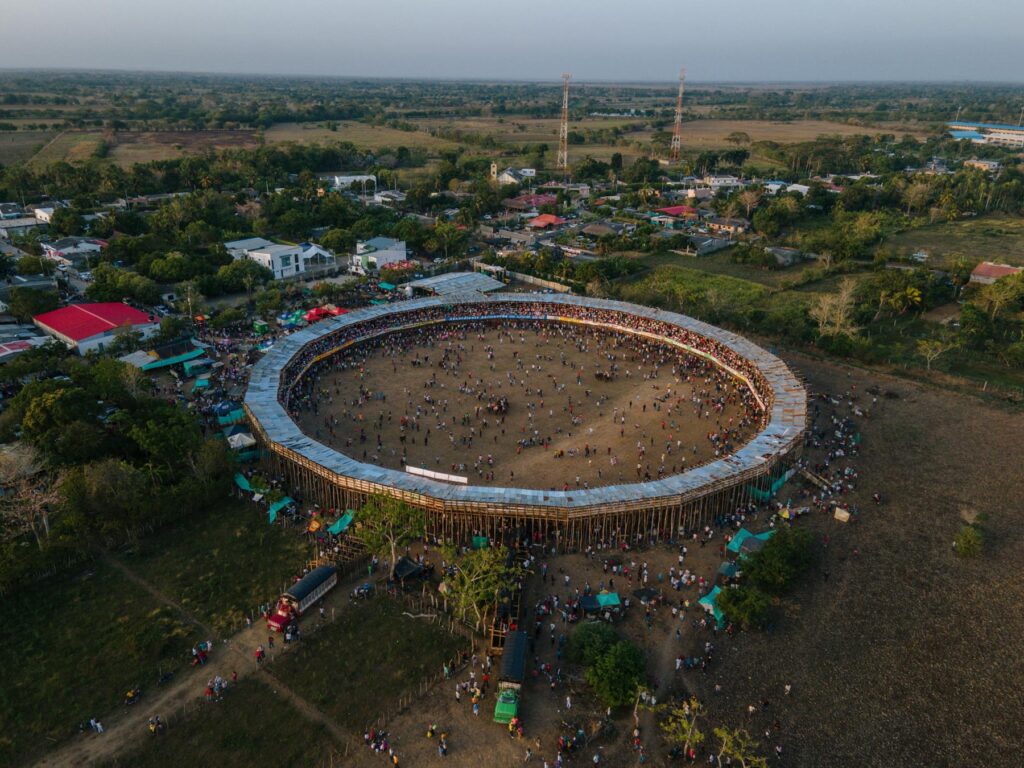
The corraleja stadium may soon be a thing of the past.
Carlos Parra Rios
This affection is not shared by all those in Colombia. Gustavo Petro, the country’s first left-wing president, has promised to end the corralejas.
“I’ve asked all the mayors of the country to stop organizing shows of death,” he tweeted. “Colombia is a country of beauty not savagery.”
The president spoke for millions of Colombians who loathe the corralejas, calling it a blood sport, an abuse of animal and man. When videos of bullfighters dying go online, the comments can be split between commiserations and those cheering on the bull.
“My cause is the rights of animals,” Sen. Andrea Padilla says in her crisp Bogotá accent. “Wherever they are victims of violence, me, and I know thousands of other Colombians, are ready to speak up.”
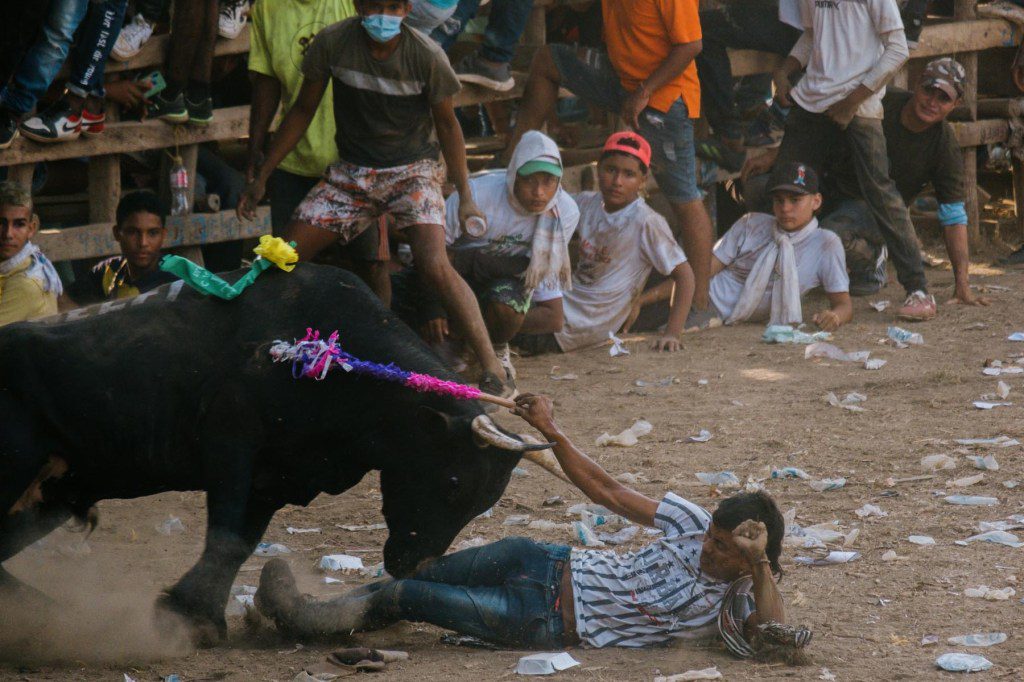
A young banderillero, lying on the sand, stabs the bull with the banderillas before being charged.
Carlos Parra Rios
A lifelong dedication to animal rights earned her a seat in Colombia’s senate. She still volunteers at animal-rescue foundations and sterilization programs for stray cats and dogs, and she wants the corralejas shut down — forever.
“These are shows of violence against animals, whose aim is to make the animal suffer, to torture them,” Padilla says, and she has introduced legislation that would ban the corralejas, as well as traditional bullfighting and cockfighting. “These are violent spectacles that are good for no one, and keep these towns submerged in a culture of bread and circus, and so they don’t get important necessities like health, education, and safety.”
The bill advanced through the legislature, posing the biggest legal challenge to the corralejas, threatening to outlaw them (corralejas are only allowed in those parts with a tradition of holding such events).
And as it progressed, it was sunk in committee before it could reach a vote.
Padilla wants to put forward more legislation, but also intends to put the question to the Colombian people. “We’re moving forward with the referendum, where the citizens can decide if these cruel spectacles can keep existing in Colombia,” Padilla says. Sooner, not later, the corralejas will be banned, she adds.
The view among many of the locals, those who enjoy the corralejas: It’s not for everyone, but it’s important to us. “I’m born into this. It’s our thing. If you ask someone from the rest of the country, like Bogotá or Medellín, they may not like it. But this is our thing, it’s innate in us,” says Samuel Negrete, a doctor who for years has tended the drunk, heat-afflicted, and wounded of the corralejas.
We’re gladiators, says one bullfighter. This is tradition, the human being against the beast.
THE TINY TOWN OF COTORRA holds the “mother of the corralejas,” one of the largest and longest-running. A man steps into the ring, tall and skinny, kneels quickly, touches the dirt, and crosses himself. A legend of the sport, fans wave to him. Outside the ring, he is Sinibaldo España Saltarin. As he waits for the bull, he is Saltarin, the bullfighter.
“When I’m in the ring, I’m someone else. The world changes. It’s all different. I don’t know how to explain it. And when I step out of the ring, it changes back,” he says. Other bullfighters say the same: that the ring is another plane of existence, that life is sped up, concentrated, with all the dull bits removed.
Today, Saltarin wears a black T-shirt, jeans, and his trademark sunglasses. He is easygoing, with a ready smile. He carries a large cape, orange on one side, purple on the other, and a long scar across his neck, a reminder of when a bull was faster. I ask him what happened. “Not much. Only, the bull nearly ripped my veins out,” he says with a shrug and a laugh.

Sinibaldo España, nicknamed “Saltarín,” shows his skill with his capote when facing a bull at “The Mother of the Corralejas” in Cotorra, Córdoba, Colombia.
Carlos Parra Rios
Now, he joins 10 other bullfighters in front of the big metal door to wait for the bulls as thousands look on. To step in front of the animal, these men must overcome primal survival instincts hardwired into our brains. “You can’t be scared, because then you’ll fail,” Saltarin says. “Fear makes you hesitate, it stops you from acting decisively. If you’re not going to act decisively, don’t do it.”
Saltarin is a capotero, a man who uses a cape and theatricality to excite the crowd. The metallic door clangs open and the bull charges. He draws the bull in, waving his cape firmly, graceful and quick. The bull races forward. At the last moment, he steps to the side and the bull runs through the cloak, horns passing inches from Saltarin’s chest. The crowd cheers as he works the bull in a flurry of twists and turns, bringing the bull in, once, twice, three times.
“When you’re working the cape, it’s a dance, like I’m dancing with death,” he tells me. “Death is a friend, loyal. She’s always at your side, even if you can’t see her.”
Saltarin shouts at the bull and flicks the cape again to lure it in, and again the bull charges him. Again, at the last moment he steps out of the way. The audience cheers.
Saltarin grew up poor on farms in the countryside. A desire for some quick cash and to impress his friends and neighbors — and a taste for danger — led him to the corralejas.
“I don’t have adrenaline, adrenaline lives in me,” he cackles. “It drives you to do crazy things, all for the action. This addiction to adrenaline is dangerous.”
In the ring, the complexities of modern life — bills, taxes, relationship dramas — all fade away. Existence, he says, becomes as simple as “Will I triumph, or will I fail? Am I going to live or die?”
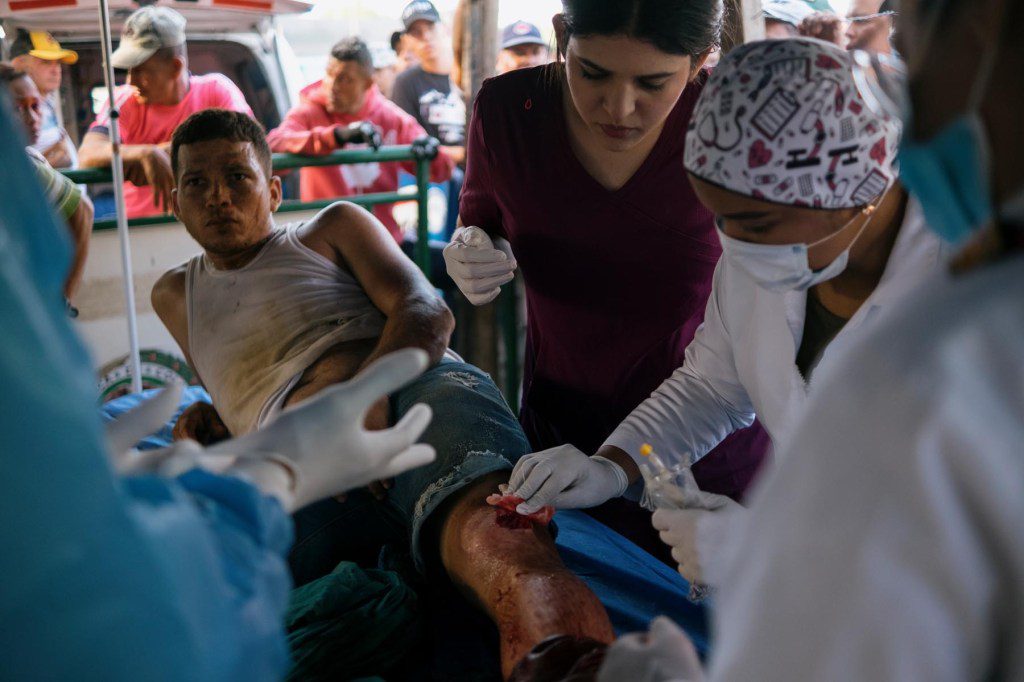
Inside the medical tent, nurses tended to Omar Lopez after a bull ripped open his leg.
Carlos Parra Rios
The bullfighters enjoy the old carnival life, traveling from town to town to risk their lives in these six-day spectacles. Beds are hammocks slung under the coliseum’s stands, and breakfasts are cold beers. They go by names like “the Mask” (whose face has been disfigured repeatedly by bulls), “the Death” (once so savagely gored the audience was sure he had left this world for the next), “the Ball,” “Mandarina.” One goes by the name of “Dickface” (Carechimba), and I’ve never had the courage to ask him why. “Crazy Horse” is known for his cowboy hat and his little dances in the ring. In a 2022 corraleja, a bull was too quick, too strong, and brutally wounded him. Doctors struggled to save his life, and to do so, sawed off his left leg. Now, Crazy Horse returns to the corralejas to drink rum with his old bullfighting buddies with his shiny metal leg. A stream of fans take selfies with him, and he accommodates each request with a smile.
This life is carved into the bodies of the bullfighters — crisscrossing scars. “Fifty-six gorings I’ve had,” says the Death, ugly scars crossing his body like a map. His life in the ring has left him only a few teeth.
Alvaro Nova is a rarity, one of those who survived long enough to retire. From the cosmopolitan Cartagena, he followed a bullfighting uncle into the ring more than 50 years ago, practicing with young bulls when he was eight years old. His choice was the cape, waving it back and forth in front of the violent bull.
“It’s a sport because you must prepare yourself physically,” he says. “But more than that, it’s an art, like a song, like music, like a painting. They call it the ‘ballet of death.’” Nova retired because of the lack of steady money. “Here, we earn whatever pesos we can get — playing with our lives. This can be a tragedy,” he says, and chuckles. “I love the corralejas.”
This sport is too off the grid and chaotic to keep statistics, but deaths are common. I’m told that nine bullfighters were killed in the past few years. Unsurpisingly, the Suicide Men embrace the role of death in their lives. “We’re gladiators,” says Saltarin. “The fight of a man against animals, the way the slaves earned their freedom. This tradition starts there. The human being against the beast.”
When I’m in the ring, I’m someone else. The world changes. I don’t know how to explain it.
THE CORRALEJAS ARE as much a party as a sporting event, and spectators and bullfighters spend the day drinking. Many of the bullfighters live in a haze of booze, starting in the morning. A few shots of rum before an afternoon of the bulls can steel nerves. In the ring, they pass bottles back and forth for quick swigs.
“No one sober would fight the bulls. You’ve got to be at least tipsy so you’re less afraid of the bull,” says the Ball, a personable bullfighter and one of the few whose face is not drawn in scars. “It’s always better to be a little drunk with some rum in you.”
Once the afternoon of bulls is over, the night comes with music and dancing, and the drinks keep flowing to now celebrate another day survived. Much of the money earned during the day is spent at the bars made of wooden planks that surround the arena. Bullfighters can be opaque about how much they earn. Rarely have I received a straight answer (and maybe it’s none of my business). Some have told me that the wages are constantly going down, that just more than a decade ago they could earn at least 3 million pesos (about double the monthly minimum wage) for six days of work, and more in tips.
At 3 p.m., a huge firework explodes in the middle of the ring, announcing that the first bull is about to be released. The ring becomes a swirling mass of activity. Most of the hundreds of men below are the so-called ducks; amateurs, there to be close to the action, to test their bravery. They hang from fences, they run in front of the bull.
Everything moves fast. A bull can sprint 35 mph. Even if you’re on the other side of the ring, you’re never more than three or four seconds away from an irate bull bearing down on you like doom itself.
In the crowds, men sell to the thirsty, carrying buckets filled with ice and beer. And when the bull comes, they run for their lives like everyone else, careful not to drop a single can. Other men carry huge publicity banners for local businesses or politicians around the ring.
Men dress as devils and pose for photos, a clown walks around shouting jokes, a man enters the ring on his motorbike, which has a set of horns at the front, and drives through the crowd. And that’s the point of a corraleja: It’s this massive spectacle and everyone has their role, be it the spectator who funds it, the ducks who provide the thrills, or anyone else who wants to put on a show.
A dozen mounted horsemen huddle together. The horsemen are a key part of Spanish bullfighting, to tire the bull ahead of its final death at the hands of the matador. Here, the riders chase the bull around the ring. Another import from Spanish bullfighting are the banderillas, sticks wrapped in shredded paper and topped with harpoon-shaped blades. Some bullfighters run in front of the bulls to stick these in the beast’s flanks, leaving bloody but shallow flesh wounds. But that the bull bleeds at all is reason enough for animal-rights advocates to call it “torture” and demand an end to the corralejas.
The wealthy cattlemen are the center of gravity here. It’s a group of 20 or so who share bottles of imported whiskey. There’s a constant back and forth between the cattlemen and the bullfighters below as they negotiate money for each trick. A young man runs up and offers to do the “seat of death,” a dangerous trick where the man must sit in front of a running bull and lie down at the last moment, and hope the bull somehow runs over him or doesn’t stop to gore him. I’ve seen men mauled to death attempting this trick. The young man demands $60. The cattleman won’t pay more than $20. No deal.
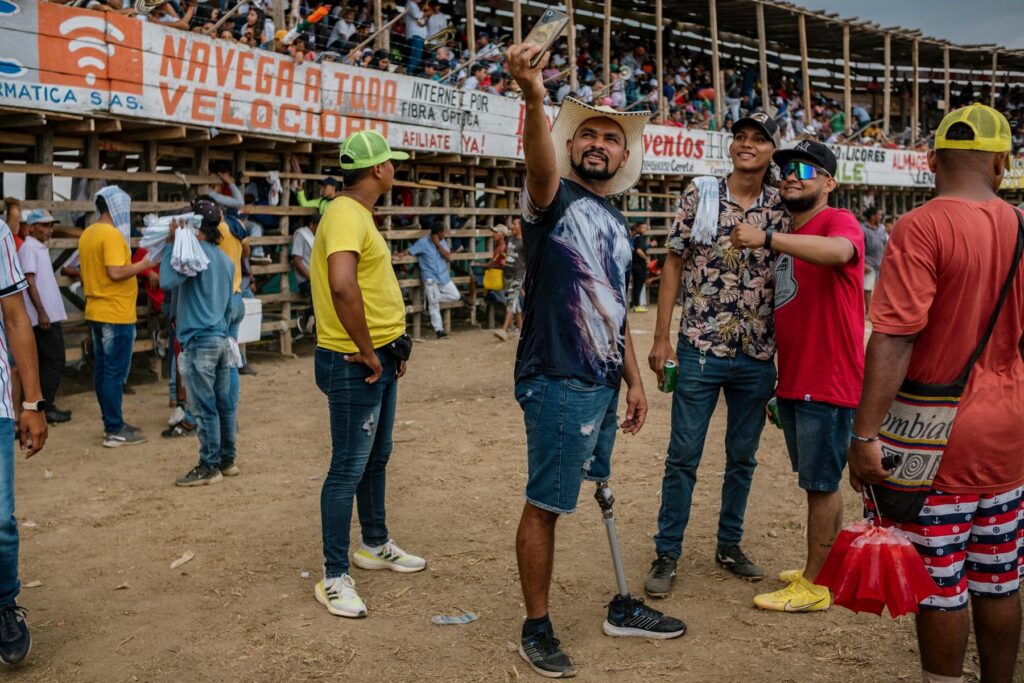
Bullfighter “Crazy Horse” returns to visit friends. He lost his leg due to a corraleja.
Carlos Parra Rios
From the stands, spectators toss dozens of packs of candy down onto the bulls, daring the men below to edge closer to the beast. One man throws a wad of cash down into the ring, creating a scrum of men scrambling in the cloud of bills. And if there’s ever a slowdown in the pace of the afternoon, a spectator will shoot a firework into the crowd.
The fans salute a good bull’s performance, his taste for the fight. The best bulls become legends. “Seven Boxes” earned his name after sending seven men to their coffins.
The sport’s death toll makes the corralejas a world of ghosts. And sometimes they visit. Widows pass through the stands carrying large photos of their dead bullfighting husbands, their hands out in the hopes of a little help. Today, old man Moises Machado is led by a young man. Words on a large white collection box tell Machado’s story, of how he once fought the bulls, but a goring left him voiceless and crippled.
Back in the ring, a bull shoots out of the metal door like a cannonball, and the audience cheers. He’s tan, a large white line running down the center of his face. The bull tears through the crowd as men run, narrowing in on one fleeing man. Screams rise through the crowd. A moment before the inevitable, the man puts out his hand as if that might stop the beast. The bull smashes into the man’s waist with such force it flips him in the air, his feet flying over his head. The blow sends him 20 feet across the ring, knocking a shoe off. He lands face first in the dirt, crumpled and motionless.
All of this occurs in seven seconds.
The bull trots to the other side of the ring while men pick up the young man and carry him out.
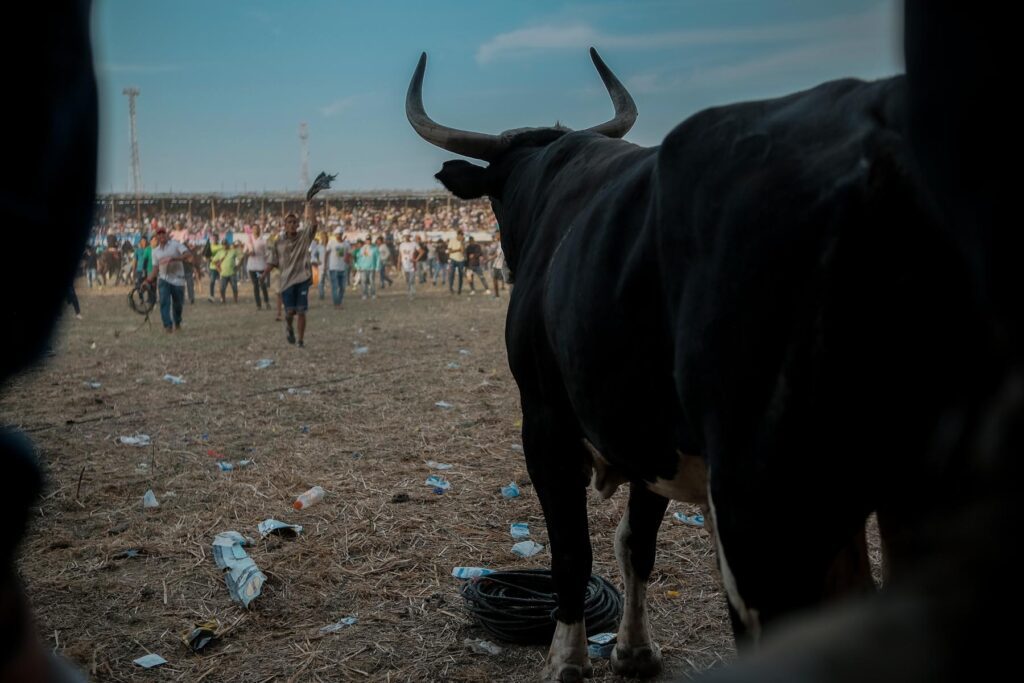
A bull is provoked by amateur bullfighters near the bullfighting event “The Mother of the Corralejas.”
Carlos Parra Rios
In the medical tent next to the coliseum, the doctors and nurses hear the screams as the young man is flipped by the bull. That’s their sign that a man has become a patient and is on his way. “Medical tent” is a grand term for four metal poles with a tarpaulin roof. Samuel Negrete, a doctor at the local hospital, today is running the medical team of another doctor and five nurses. Two ambulances are ready to go, their back doors open, their engines running.
The man is delivered motionless and quickly put on one of the medical tables. There’s a question as to whether he’s dead or not. Negrete checks his signs — he’s alive and lucky, the bull’s horn hasn’t pierced him. As Negrete looks the man over, crowds of people encircle the tent, craning to see the day’s injured.
After five minutes, the man regains consciousness, but is groggy and unsure where he is. A neck brace is fitted, and he’s driven to the local hospital.
“A normal day is five, six, seven injured. They’re injured in their throats, abdomen, their heads,” says Negrete during a brief break between patients. A common injury is men being gored in their anuses. “It happens a lot. The man is running away from the bull and the bull reaches him, and the part most affected is the anus. There are tears and punctures.”
The tent provides triage — there’s a limit to what they can do with bandages and a couple of medical beds. “Sometimes they come in with total cardiac arrest and die right away. If there is serious trauma to the thorax region, it’s sometimes impossible to save them in a setup as basic as this one.… There are afternoons when there are two or three deaths.”
Negrete is young and personable. He enjoys the corralejas even as he’s conflicted over the price of the spectacle. “Ninety percent who arrive here are not the bullfighters, but the ducks, those who went looking for death,” he says. “It’s frustrating — because you ask yourself, ‘Why did they risk their life?’”
We’re interrupted by another collective scream from the ring — another patient is on his way.
Omar Lopez is carried in by his friends. He’s a young bullfighter in his twenties, his left trouser leg drenched in blood. He grimaces, keeping his eyes off the wound. His sister, Yuli, follows him.
“Look at you! What’s our mother going to say?”
Sheepish, Lopez lies on the medical cot as Negrete cuts off the trouser leg. The bull’s horn has ripped open his left knee. Lopez clenches his teeth and looks away. Blood pours out of his leg.
“The bull got him. It went for him three times, and he didn’t understand it was trying to kill him,” says the sister, watching Negrete tend to her brother’s leg. Her face veers between anger and concern. “It’s not the first time a bull almost killed him. My mother will die if she hears.”
Negrete and the nurses clean the wound, bandage the gash. For a nasty cut, Lopez is in good spirits, now laughing and winking with the nurses. He’s an eight-year veteran of the corralejas.
“I’ll be back in the ring as soon as I can,” he says. “Maybe tomorrow?” He hobbles back to the stands to show off his wound and ask for tips.
Over the afternoons, the tent also tends to people passed out from the heat. The sun hits hard here, with temperatures that hover around 100 degrees and people crammed into the stands. One day, three women are brought in, passed out from the heat.
“We live this every day in the time of the bulls,” says Negrete.
Negrete and the nurses sit for a break. And then come the screams, and up they jump, ready for the next patient. The flow of patients reminds me of the field hospital I saw outside Mosul as the Iraqi army battled ISIS.
Luis Sandoval, 62, is carried in by four men, their arms covered by his blood. His face is pale, his shirt and jeans both drip red with blood. On the back of his thigh is a hole that pumps dark blood onto the cot. Negrete applies pressure to the wound and finally manages to maintain a bandage over the wound.
Sandoval, says a friend, was in the ring, hanging from the fence. The bull stopped beneath him, reared itself up, and gored him then and there.
Now, Negrete moves to the second wound, in Sandoval’s side. As he treats the dark hole, Sandoval’s intestines slither out, like pink sausages. Negrete cups the intestines and tries to push them back in, but they won’t go. Those peering into the tent gasp at the sudden stench.
“His intestines have been pierced,” a nurse shouts.
Sandoval looks straight ahead, away from his wounds. There’s terror in his eyes, and his skin grays by the second.
Finally, Negrete bandages the wound, an ugly bulge of the intestines visible under the gauze. Negrete has saved his life, but Sandoval needs surgery if he’s going to survive. As the old man is carried to the back of the ambulance, more screams come from the ring. And the music never stops for a second.
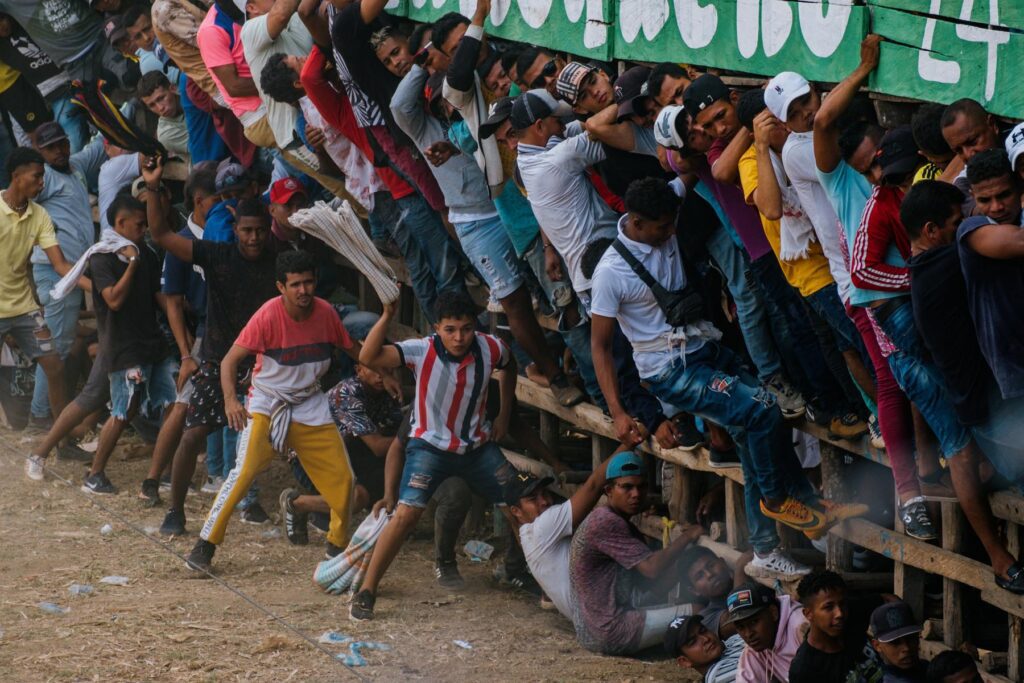
The crowd hangs on to the grandstand — shaking the arena — provoking the bulls.
CARLOS PARRA RIOS
AS THE DAYS STRETCH ON, the corralejas take on a dream state. It’s where you eat, where you see your friends, where you dance and listen to music, where you drink rum until you fall asleep, wake up and do it again. A dark party that never ends. One night, I dream of charging bulls.
“When you live in this world, it traps you — it’s a spell,” says Saltarin. “You don’t focus on the dead, you look away, you look at the people having a good time.… And the party never stops, it keeps going.”
The Death calls it the “devil’s party,” a dark carnival you can never leave. “The money you make here is cursed, only meant to be spent drinking rum.”
For some, it becomes a vortex impossible to escape from. The last time I saw Catalino, the man who jumps over the bull, he was bathing his baby daughter in his house and thinking on retiring from the sport. “I’ve been thinking I’m giving away my life for nothing,” he said. “I have to think ‘How can I help my baby if I’m dead?’”
Catalino would quickly spiral out of control. The constant rum led him to harder drugs. The money made risking his life in the ring went to feed his addiction. The star of the corralejas fell to living on the streets, cut off from his family. Someone posted his photo on Facebook looking for any friends and family to help him. Catalino stands there in filthy clothes, a man lost to addiction, demons now in control.
Some try to plan an exit from the corralejas, to not let the arena win. Mandarina is one of the legends of the sport. “In bullfighting,” he says, “you want to leave this in the best way possible, leaving behind the best image of yourself.” He’s instantly recognizable for his black shoulder-length curly hair, a deep scar that cuts along his jaw, ending at his lips, a memento of the afternoon when the bull got too close. Among the rough Suicide Men, Mandarina is a gentleman, nicely turned out — jeans, a shirt, white sneakers (the nickname comes from a childhood job of selling the fruit on the street). For nearly 20 years, Mandarina and Saltarin have traveled together, brothers in the corralejas. But the deaths of the bullfighters haunt him.
“Death is hard to take. To see a friend die, gored by the bull, that’s when you feel the fear. Just as it happened to him, it could happen to you,” he says, thoughtful. “In this moment, I’ve got a touch of this fear in me. When you face off against the bull and you feel the fear, you really know fear.”
Mandarina thinks on his family: his young daughter and son. “I’ve set up a little farm, so when I retire from the corralejas, I’ll have something,” he tells me. “I don’t know when that’s going to happen because I’m still young.”
Mandarina is one of the few who you can imagine in a life beyond the rum, meeting death in a bed at a ripe old age, far from a rampaging bull’s horns.
And I wish the story had ended that way.
On the first afternoon of the corralejas in the town of Planeta Rica, in a hellish heat, Mandarina works the ring. Saltarin is in the stands, a bad feeling telling him to skip the bulls that day. “I told Mandarina not to work that afternoon. I was watching in the stands …” and he runs out of words.
The bull charges out of the metal door, dark brown, 400 kilos of mass on a mission to destroy. A bullfighter tries to work the cape, but the bull charges right past him and lands heavy into Mandarina’s chest. He’s flipped in the air, landing on his back. The bull curves around, his head lowered, horns at the attack — and repeatedly stabs Mandarina, shoving him across the ring until he’s pinned against the fence. The audience screams in horror. Mandarina is dead at 47.
In between the corralejas, to raise a little extra money, Mandarina was working as a motorcycle taxi. One life where he’s a star in the ring, adored by tens of thousands, and another life where he ferries people around on the back of his bike for 50 cents a trip.
Mandarina was buried with honors in his hometown, hundreds lining the streets to say goodbye as bullfighters and bands marched in the funeral procession. One swirls Mandarina’s cape around for a final twirl. And then he is buried amid music and tears.
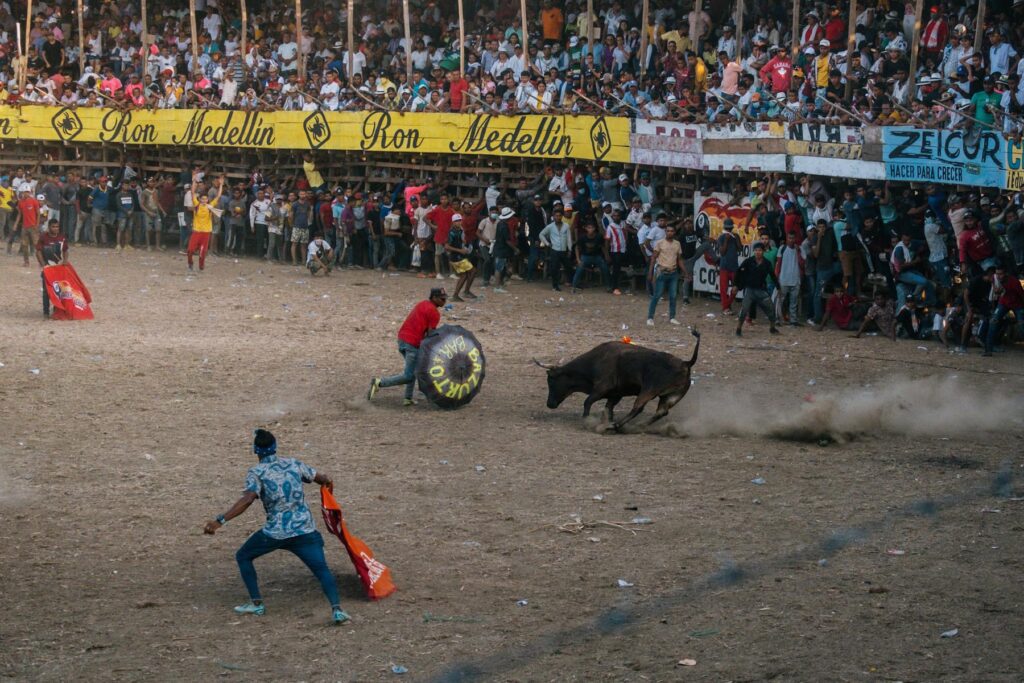
The capoteros use a cape and theatricality in the ring to excite the crowd.
Carlos Parra Rios
A few months later, Saltarin would lose another companion in the corralejas, “El Mono Villegas,” one more death in the afternoon.
“I thought about retirement after losing two friends. I was going to retire,” Saltarin says, a tear rolling down his cheek. “I said that I was leaving. No one accepted it. They insulted me. They called me a coward.” Rising, he gives me a fist bump and walks off.
When I catch up with him a few months later, he tells me he’s quit. “I want to change my life. I’ve left the corralejas,” he says. “Almost all my friends have become memories. I don’t want to become a memory, Toby.”
I feel relief. I had been haunted by my last memories of him at the corralejas: walking by himself after drinking with friends. He seemed alone in the world, knowing that soon another bottle of rum will be opened, the big metal door will swing wide, and a bull will charge out as a man steps forward, risking all to give the audience another show.





